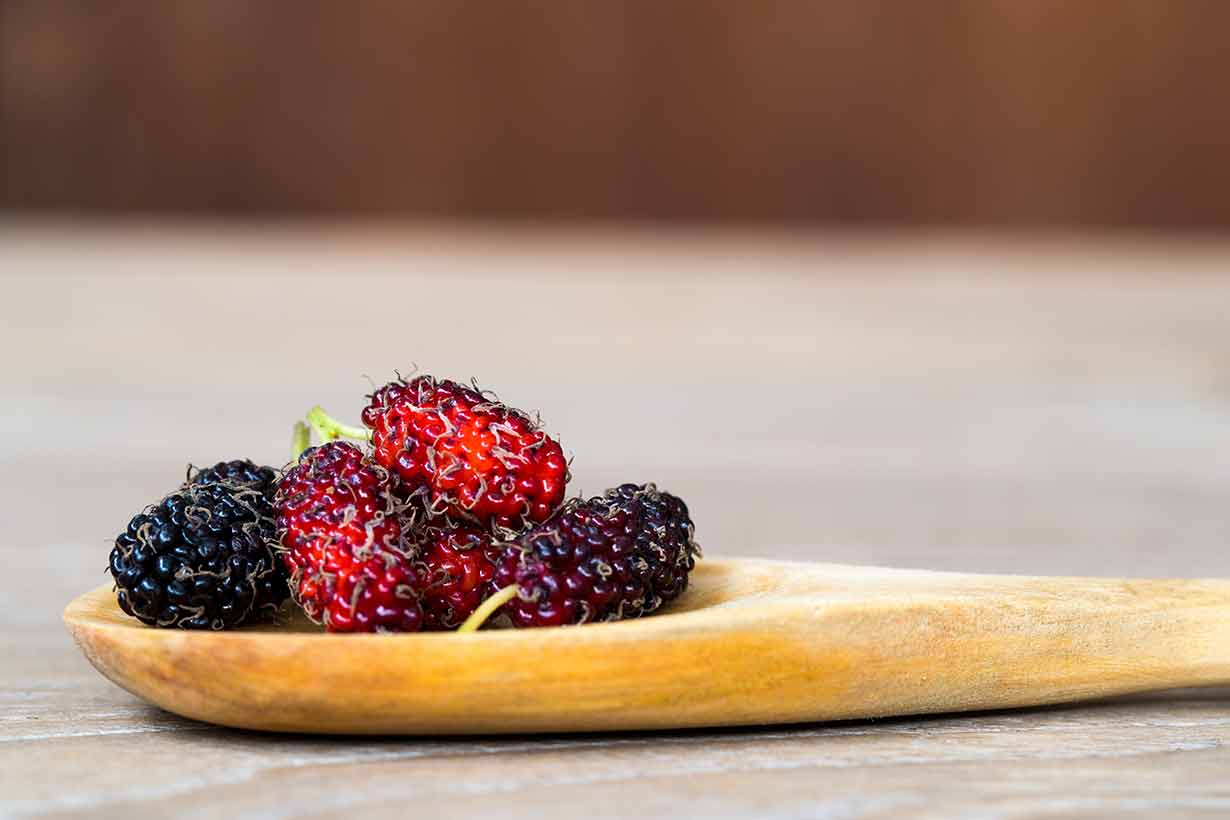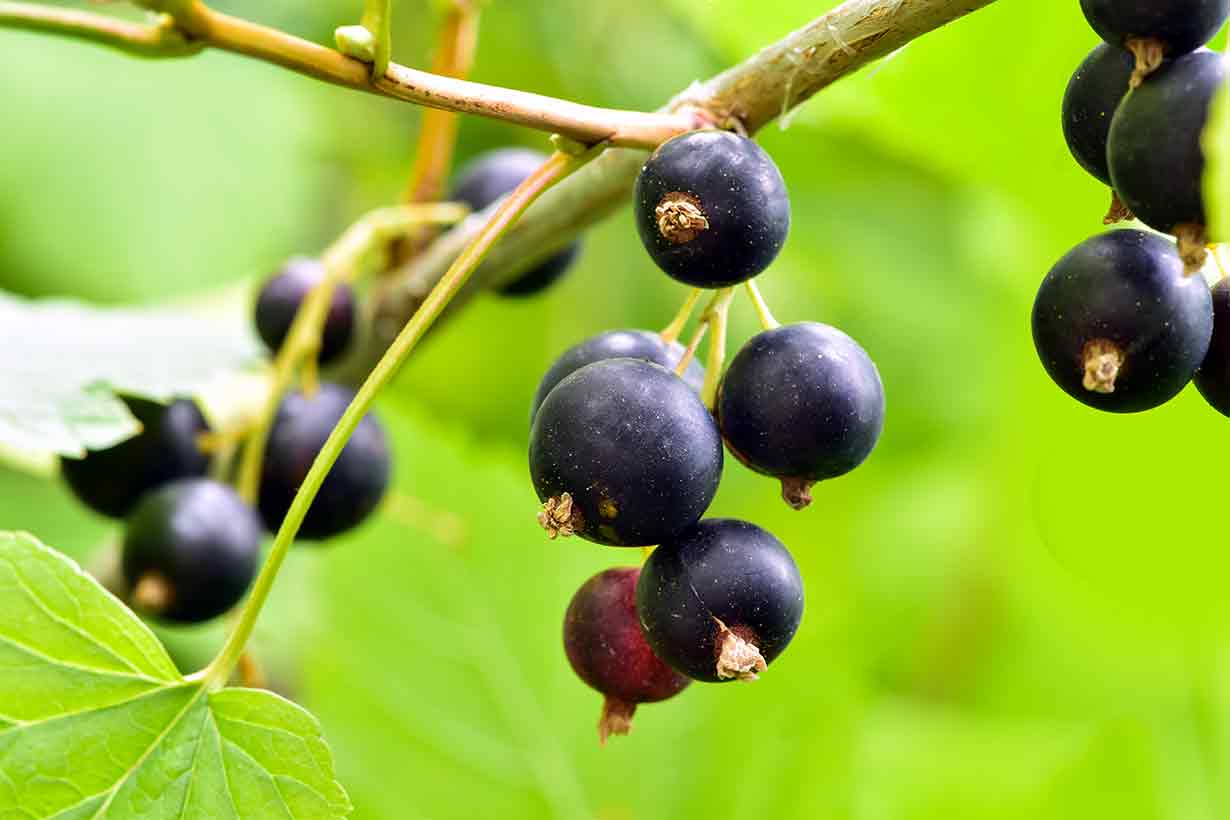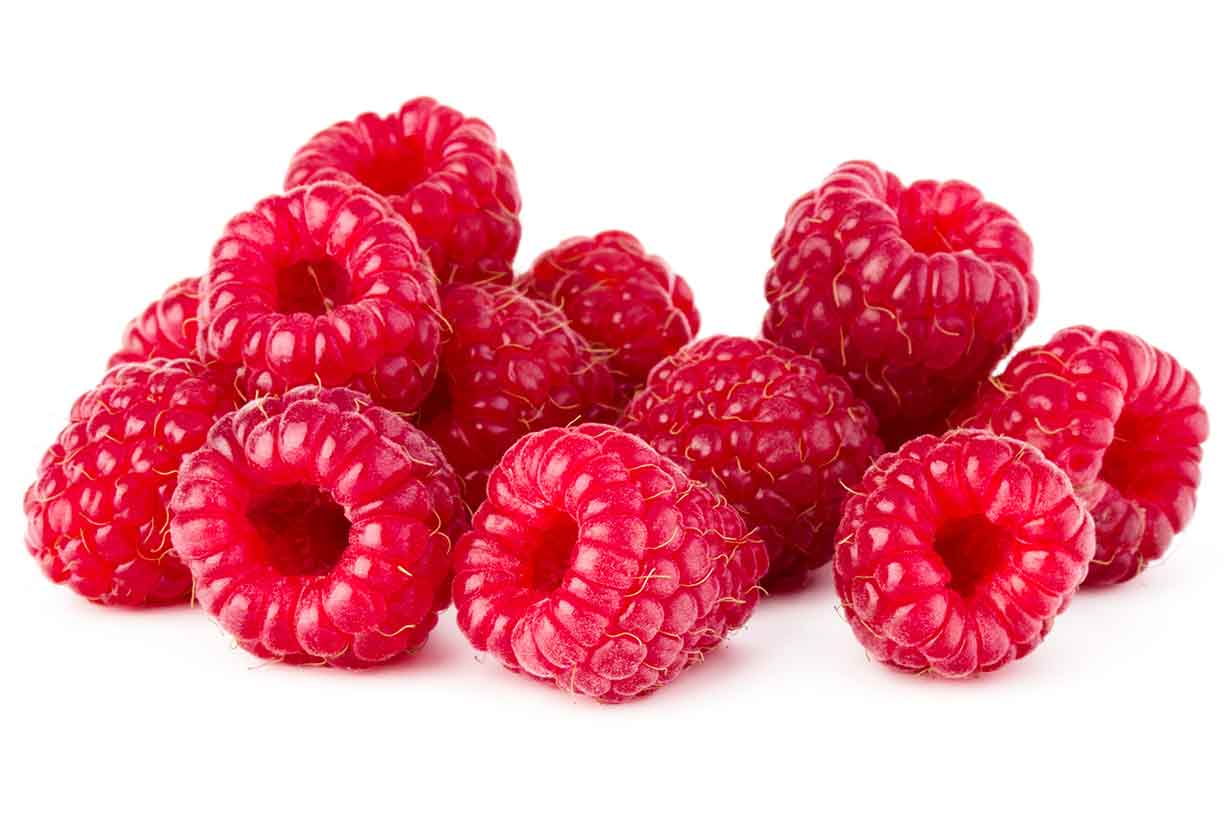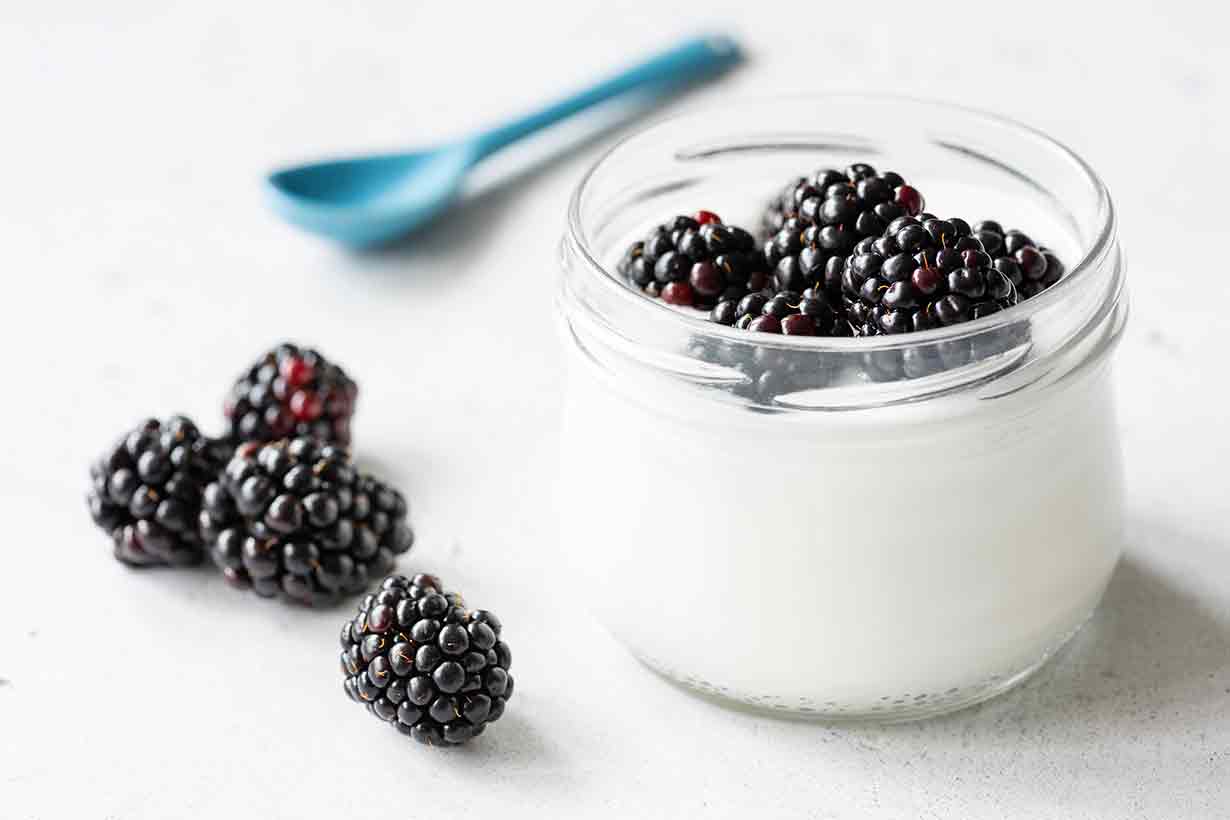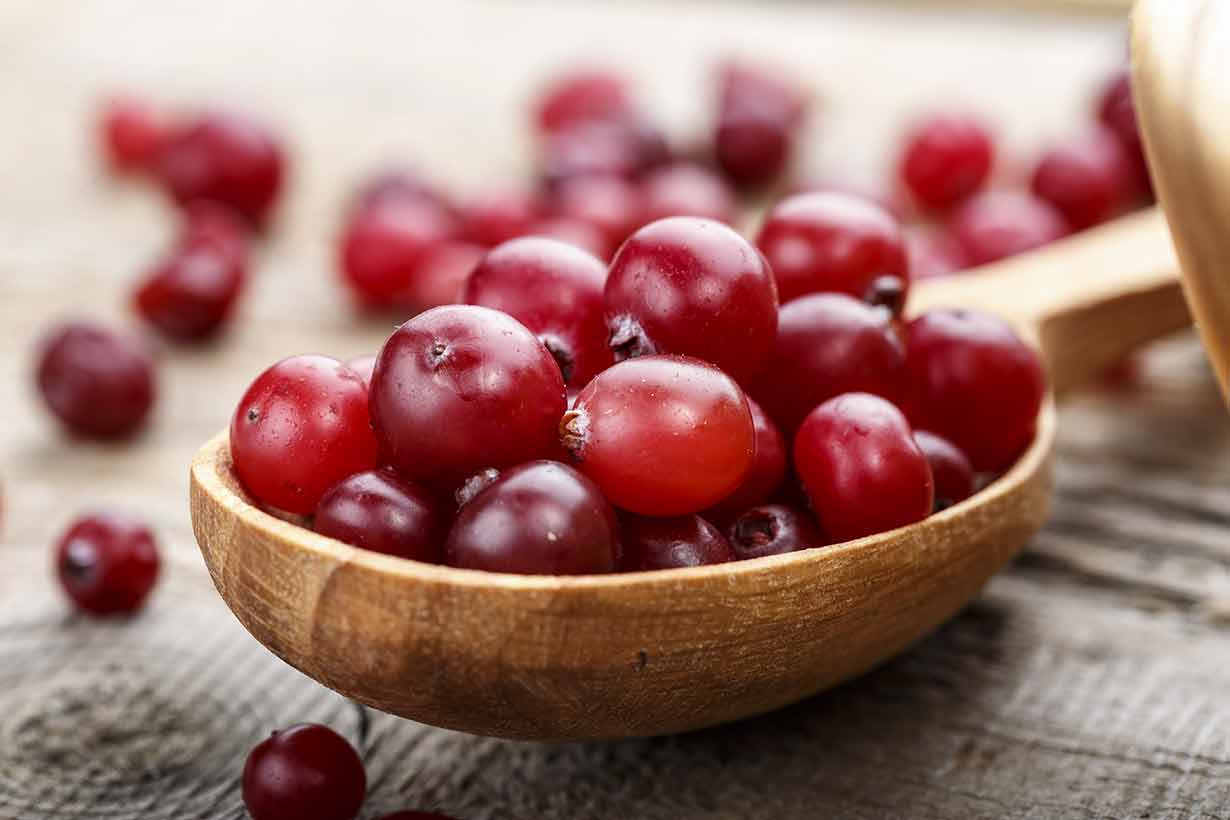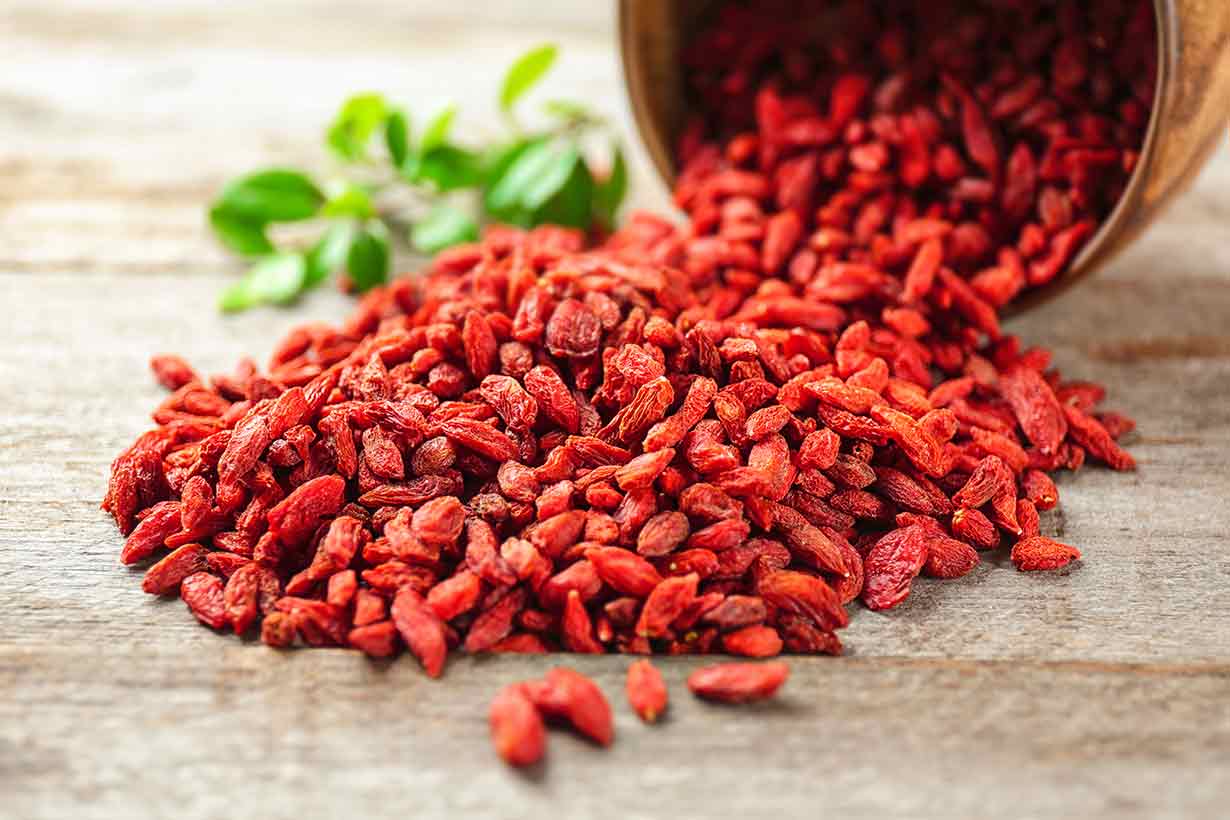Strawberries are among the best-tasting fruits in the world and arguably one of the healthiest.
This article examines this popular berry’s nutritional profile and potential health benefits.
As part of this, we will look at some of the latest research findings on strawberries.
Table of contents
What Are Strawberries?
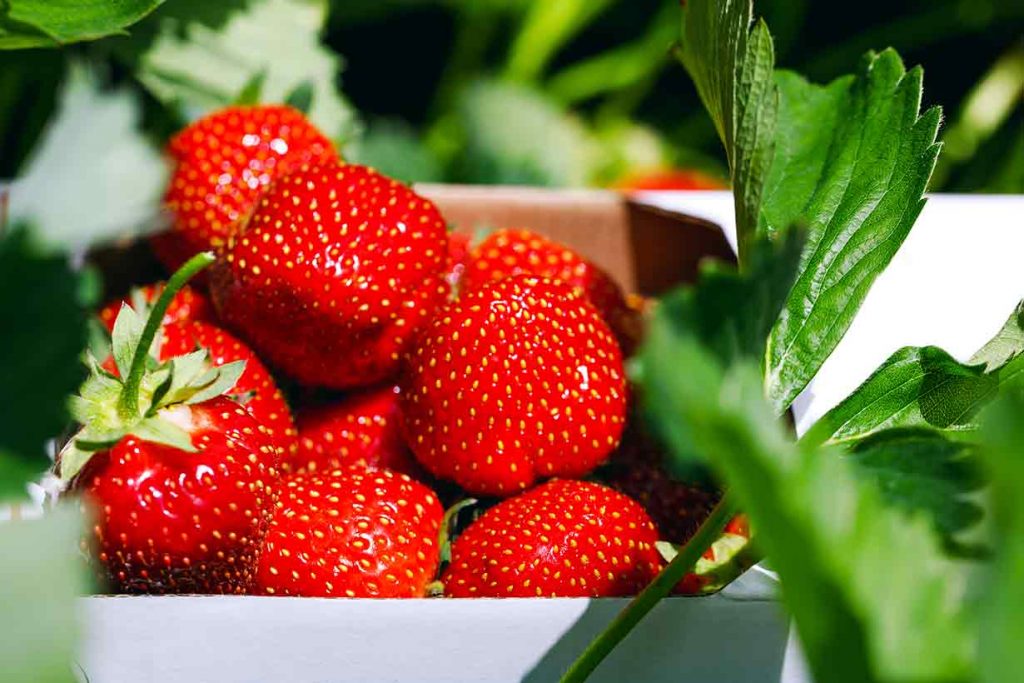
Strawberries (Fragaria vesca) are an edible fruit that grows on plants in the rose (Rosaceae) family.
The strawberry is a hybrid species, and its origin lies in France, with the first strawberries bred in the early 18th century (1).
Despite popular belief, strawberries are not a berry botanically, and they are botanically different from genuine berries such as blueberries. Scientifically, the strawberry is a receptacle, also known as an “aggregate fruit” (2).
However, culturally strawberry is widely known and used as a berry. With a deep red color, a sweet, juicy texture, and a pleasant aroma, strawberries are a favorite fruit worldwide.
From supermarket shelves to cosmetic stores, strawberries are widely used in various food products, drinks, and fragrances.
Types of Strawberries
Interestingly, there are three different varieties of strawberries;
- Day-neutral strawberries: this variety was developed to provide fruit throughout the summer and autumn/fall seasons.
- Everbearing strawberries: their name isn’t quite technically true, but this kind of strawberry grows fruit from spring until fall.
- June-bearing strawberries: as the name suggests, this variety has one harvest somewhere in June.
There are dozens of different cultivars within these three groups, and they all have slight variations in appearance and taste.
One of the most notable cultivars is the pineberry, which is sometimes referred to as ‘white strawberries.’
Generally speaking, they all have a similar nutrition profile.
For anyone wishing to know more about these different types of strawberries, Iowa State University has an informative guide.
Nutrition Facts
The following tables show the full nutritional values for strawberries per 144-gram cup serving. The source of the nutritional data is the USDA’s FoodData Central database (3).
Daily values (% DV) are based on a 2000-calorie diet and have been calculated using the FDA’s published daily values (4).
| Name | Amount | % Daily Value |
|---|---|---|
| Calories | 46 kcal | |
| Carbohydrates | 11.1 g | 4.0% DV |
| Fiber | 2.88 g | 14.4% DV |
| Sugars | 7.04 g | |
| Fat | 0.43 g | 0.6% DV |
| Saturated | 0.02 g | 0.1% DV |
| Monounsaturated | 0.06 g | |
| Polyunsaturated | 0.22 g | |
| Omega-3 | 0.09 g | |
| Omega-6 | 0.13 g | |
| Protein | 0.97 g | 1.9% DV |
Calories
Strawberries are a low-calorie food and contain only 46 calories per 144-gram cup.
Carbohydrates
Strawberries are one of the lowest-carb fruits, containing 11 grams of carbohydrates per 144-gram cup.
Nearly three of these carbohydrate grams are from fiber.
Fat and Protein
As a plant food that is predominantly water and carbohydrates, strawberries contain negligible amounts of fat and protein.
Vitamins
| Vitamin | Amount | % Daily Value |
|---|---|---|
| Choline | 8.21 mg | 1.5% DV |
| Folate, DFE | 34.6 mcg | 8.7% DV |
| Vitamin A, RAE | 1.44 mcg | 0.2% DV |
| Vitamin B1 (thiamin) | 0.035 mg | 2.9% DV |
| Vitamin B2 (riboflavin) | 0.032 mg | 2.5% DV |
| Vitamin B3 (niacin) | 0.556 mg | 3.5% DV |
| Vitamin B5 (pantothenic acid) | 0.18 mg | 3.6% DV |
| Vitamin B6 (pyridoxine) | 0.068 mg | 4.0% DV |
| Vitamin B12 (cobalamin) | 0 mcg | 0% DV |
| Vitamin C | 84.7 mg | 94.1% DV |
| Vitamin D | 0 mcg | 0% DV |
| Vitamin E | 0.418 mg | 2.8% DV |
| Vitamin K | 3.17 mcg | 2.6% DV |
As the table shows, strawberries contain a substantial concentration of vitamin C and a moderate amount of folate.
Minerals
| Mineral | Amount | % Daily Value |
|---|---|---|
| Calcium | 23 mg | 1.8% DV |
| Copper | 0.07 mg | 7.8% DV |
| Iron | 0.59 mg | 3.3% DV |
| Magnesium | 18.7 mg | 4.5% DV |
| Manganese | 0.56 mg | 24.3% DV |
| Phosphorus | 34.6 mg | 2.8% DV |
| Potassium | 220 mg | 4.7% DV |
| Selenium | 0.58 mg | 1.1% DV |
| Sodium | 1.44 mg | 0.1% DV |
| Zinc | 0.20 mg | 1.8% DV |
Strawberries are a good source of manganese and copper and contain most other minerals in smaller amounts.
Strawberries Are a Rich Source of Polyphenols
Similar to other berries, strawberries provide a large concentration of polyphenols.
Polyphenols are a plant compound believed to have several benefits for human health.
The major groups of polyphenols in strawberries include (5);
- Anthocyanins: Anthocyanins provide either red, blue, or purple pigment depending on their specific PH level (6). Among the anthocyanins resent in strawberries, the most prevalent is pelargonidin.
- Flavanols: Aside from strawberries, flavanols are present in various fruit, herbs, and teas. The most significant flavonol in strawberries is epicatechin.
- Flavonols: Various fruits and vegetables contain flavonols; the major flavonol in strawberries is quercetin.
- Phenolic acids: Strawberries contain various hydroxybenzoic and hydroxycinnamic (phenolic) acids, with p-Coumaroyl glucose and ellagic acid being the most prevalent.
- Stilbenes: Strawberries contain small amounts of resveratrol.
How Beneficial Are Strawberry Polyphenols For Human Health?
Research is ongoing regarding the effects of polyphenols on human health.
A 2019 systematic review of the evidence on polyphenols remarked that, despite considerable debate on the topic, polyphenols appear to be health-promoting.
The review concluded that polyphenol-rich dietary patterns appear to have a protective effect against disease and adverse health outcomes (7).
Potential Benefits of Strawberries
This section will look at some potential health benefits of strawberry consumption.
1. Significant Source of Vitamin C
The vitamin C (ascorbic acid) content is arguably strawberries’ most significant health benefit.
Although many people believe oranges and other citrus fruits are the best sources of vitamin C, a cup of strawberries provides a higher concentration of the vitamin.
The nutrition facts section shows that a 144-gram cup of strawberries provides 94.1% of the recommended daily value (3, 4).
Vitamin C has many positive effects on the body, including its antioxidant activity, increasing the absorption of non-heme iron (iron found in plant foods), and immune function (8, 9, 10).
A 2023 randomized controlled trial looked at the effect of strawberry consumption on blood levels of vitamin C, the antioxidant potential of low-density lipoprotein (LDL), and blood glucose response.
This study demonstrated that 500 grams of strawberry puree significantly elevated blood levels of vitamin C (2-hour peak increase of 15 mcg/ml). Additionally, LDL oxidation time was significantly prolonged, suggesting an antioxidant effect on LDL (11).
2. May Improve Cardiometabolic Health and Lower Risk
Several studies have looked at the impact of strawberry consumption on cardiometabolic health.
Some of these trials, summarized below, have demonstrated that strawberries may improve several cardiovascular risk markers.
Basu et al. (2023)
In this 14-week randomized controlled crossover trial, researchers examined the effect of low-dose strawberry powder (400 mg total polyphenols) and high-dose strawberry powder (960 mg total polyphenols) on thirty-three adults with metabolic syndrome.
These powders were each consumed over four weeks, with a washout (gap) week in between. A four-week control phase (no strawberry powder) was also undertaken.
Compared to the low-dose (and control) phase, high-dose strawberry powder improved energy-metabolism pathways and various blood markers of cardiometabolic risk (12).
Leailin Huang et al. (2021)
A randomized controlled crossover trial featuring thirty-four adults investigated the impact of strawberry consumption on cardiometabolic risk factors.
Over four weeks, compared to the control, daily consumption of beverages made with 50 grams of freeze-dried strawberry powder improved measures of vascular health, including flow-mediated dilation and systolic blood pressure (13).
Amir Hadi et al. (2019)
This systematic review and meta-analysis reviewed 14 randomized controlled trials examining the effects of strawberry supplementation on cardiovascular risk factors.
Overall, there was evidence that strawberry intake (14):
- Decreased circulating oxidized low-density lipoprotein (OxLDL), something that is associated with cardiovascular disease (15).
- Lowered levels of malondialdehyde and C-reactive protein, which are markers of oxidative stress.
- Total cholesterol and diastolic blood pressure were slightly lowered, whereas fasting blood sugar slightly increased.
This systematic review and meta-analysis suggest that strawberry consumption may improve cardiovascular risk factors.
Basu et al. (2016)
A randomized controlled trial examined freeze-dried strawberries’ antioxidant effects in sixty adults over 12 weeks.
Compared to the (no strawberry) control group, groups consuming low-dose (25g/d) or high-dose (50g/d) strawberries had increased blood antioxidant capacity and higher levels of glutathione, which is an important antioxidant (16).
Eunyoung Park et al. (2016)
In a randomized controlled crossover trial involving twenty-one participants, consuming at least 20 grams of freeze-dried strawberries daily lowered oxidized low-density lipoprotein (OxLDL) levels (17).
Further Studies
Further randomized controlled trials on strawberry intake and metabolic health have demonstrated that strawberry intake may potentially:
- Decrease diastolic blood pressure in participants with type 2 diabetes (18).
- Lower levels of C-reactive protein, a marker of inflammation, in people with type 2 diabetes as well as improved antioxidant status and blood sugar control (19).
- Lower total cholesterol levels and decrease circulating vascular cell adhesion molecule-1 (VCAM-1) levels in people with metabolic syndrome. VCAM-1 is a molecule involved in inflammation (20).
- Reduce LDL oxidation (21).
3. Good Source of Manganese
The manganese content is another nutritional benefit of strawberries.
Manganese is a trace mineral with several vital functions within the human body.
Some of these functions include a role in bone formation, the immune system, reproduction, and the metabolism of protein, cholesterol, and carbohydrates (22, 23).
Strawberries contain 0.56 mg of manganese per 144-gram cup, 24% of the daily value (3, 4).
4. Fiber Content
The absolute amount of fiber in strawberries may not compare well to fiber-rich foods on a gram-for-gram basis.
However, per calorie, strawberries offer more total fiber than whole grains. For instance, a 144-gram cup of strawberries provides nearly three grams of fiber for only 46 calories (3, 4).
Fiber has the beneficial effect of reducing the postprandial (post-meal) blood glucose response from carbohydrate foods (24).
For example, a can of cola (simple sugars) will quickly spike blood glucose levels following consumption. In contrast, eating a mixture of berries and green vegetables would have a much smaller effect since the meal would be mainly fibrous carbohydrates.
Furthermore, accumulating research suggests that fiber from fruit and vegetables is important for gut bacteria and, as an extension, overall health (25, 26, 27).
Do Strawberries Have Any Downsides?
There is no real nutritional argument for strawberries having downsides; they’re highly nutritious, and scientific research on their effects is positive.
However, allergies are a potential drawback that will affect some individuals.
Although not often considered an allergen, strawberry allergy can be prevalent in younger age groups. On this note, one study included a sample of 40 primary care pediatricians and the children they care for. The results found that strawberry allergy peaked at around 3% to 4% of two-year-old children (28).
This allergy occurs due to a specific group of proteins found in strawberries called ‘Fra a’ (29).
Anyone who suspects they may have a strawberry allergy should discuss it with their doctor.
Fresh vs. Frozen: Does It Matter?
Most people would agree that fresh strawberries beat frozen strawberries for taste.
However, some prefer frozen strawberries for their greater shelf-life, affordability, and convenience.
However, are there any key considerations concerning nutritional differences between the two?
Several studies have looked at this issue, and the answer appears that it probably doesn’t matter.
A 2015 study that evaluated vitamin retention in eight fruit and vegetables found no significant difference between fresh and frozen strawberries (30). However, a 2010 study did find that fresh strawberries had ‘higher total antioxidant activity’ (31).
All in all, the best type of strawberries is the one that best fits personal preference.
Strawberry Recipe Ideas
If reading about strawberries makes you hungry, here are some quick and simple recipe ideas.
No cooking is necessary, and they only take several minutes to prepare.
1) Strawberries and Vanilla Cream
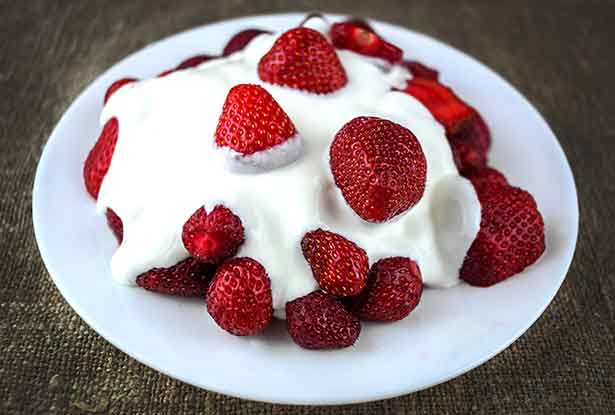
Not many things beat strawberries and cream for a dessert, but a little vanilla adds to the flavor.
- Place the strawberries on a plate or in a bowl.
- Next, mix the desired amount of cream (don’t go overboard!) with a few drops of vanilla extract.
- Pour over the strawberries.
2) Dark Chocolate Covered Strawberries

Combining two of the tastiest foods (dark chocolate and strawberries) leads to good things.
Approximately 10 grams of dark chocolate per strawberry is a good ratio.
- Firstly, gently melt a 100 g bar of dark chocolate (cocoa percentage as per personal preference) in a pan.
- Next, add ten strawberries to the pan and ensure they are well-coated with the chocolate.
- Refrigerate the chocolate-coated strawberries for several hours; the chocolate will cool and harden.
3) Strawberry Greek Salad
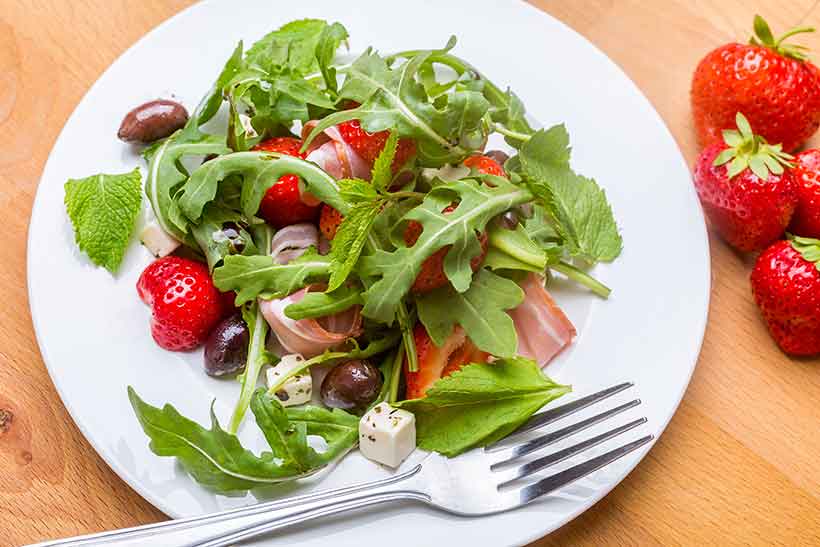
While most salads feature leafy greens and tomatoes, strawberries can work well for a light and refreshing summer salad.
- First, combine the strawberries with some salad foods of choice. Some foods that could work well include ham, feta cheese, olives, leafy greens, cucumber, red onion, and grated carrots.
- Secondly, add a tablespoon of olive oil, a tablespoon of freshly squeezed lemon juice, and a teaspoon of balsamic vinegar.
- Mix well.
Final Thoughts
Strawberries are a nutritious fruit that offers a significant source of vitamin C, polyphenols, and a broad range of nutrients for minimal calories.
Additionally, studies suggest that strawberries may have a range of promising potential health benefits.
Strawberries can play a nutritious (and delicious) role in a healthy diet.



